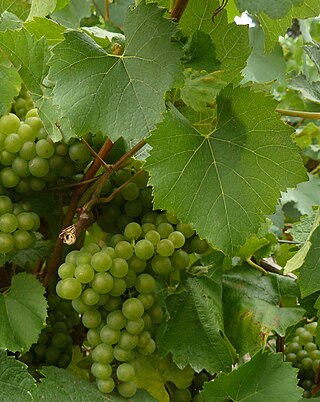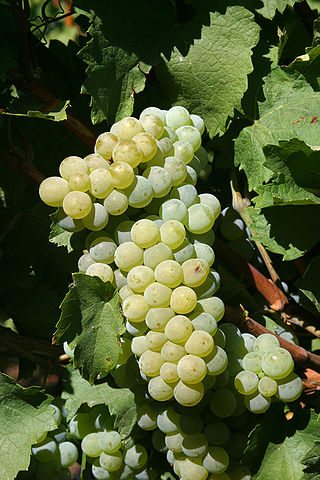Related Research Articles

Chardonnay is a green-skinned grape variety used in the production of white wine. The variety originated in the Burgundy wine region of eastern France, but is now grown wherever wine is produced, from England to New Zealand. For new and developing wine regions, growing Chardonnay is seen as a 'rite of passage' and an easy entry into the international wine market.

Pinot blanc is a white wine grape. It is a point genetic mutation of Pinot noir. Pinot noir is genetically unstable and will occasionally experience a point mutation in which a vine bears all black fruit except for one cane which produces white fruit.

Furmint is a white Hungarian wine grape variety that is most noted widely grown in the Tokaj-Hegyalja wine region where it is used to produce single-varietal dry wines as well as being the principal grape in the better known Tokaji dessert wines. It is also grown in the tiny Hungarian wine region of Somló. Furmint plays a similar role in the Slovakian wine region of Tokaj. It is also grown in Austria where it is known as Mosler. Smaller plantings are found in Slovenia where it is known as Šipon. The grape is also planted in Croatia & Serbia, where it is known as Moslavac. It is also found in Romania and in former republics of the Soviet Union. Furmint is a late ripening variety. For dry wines the harvest starts usually in September, however sweet wine specific harvest can start in the second half of October or even later, and is often affected by Botrytis.

Grüner VeltlinerGerman:[ˈɡʁyːnɐfɛltˈliːnɐ] ) is a white wine grape variety grown primarily in Austria, Hungary, Slovakia, and the Czech Republic. The leaves of the grape vine are five-lobed with bunches that are long but compact, and deep green grapes that ripen in mid-late October in the Northern Hemisphere.

Hárslevelű, also called Lipovina, Frunza de tei, Lindenblättriger and Feuille de Tilleul is a grape variety from the Pontian Balcanica branch of Vitis vinifera.

Melon de Bourgogne or Melon is a variety of white grape grown primarily in the Loire Valley region of France. It is also grown in North America. It is best known through its use in the white wine Muscadet.
Crouchen is a white South African and Australian wine grape variety that originated in the western Pyrenees of France but is now virtually extinct in France due to its high susceptibility to fungal diseases like powdery and downy mildew. The grape is known under a wide variety of synonyms including Clare Riesling and Cape Riesling though it is not related to the well known international variety Riesling. Recent European Union regulation aimed at standardizing wine labelling laws has encouraged wineries to move away from these synonyms but their use still persists.

Gouais blanc or Weißer Heunisch is a white grape variety that is seldom grown today but is important as the ancestor of many traditional French and German grape varieties. The name Gouais derives from the old French adjective ‘gou’, a term of derision befitting its traditional status as the grape of the peasants. Likewise, the German name Weißer Heunisch labels it as one of the lesser "Hunnic" grapes.

Clairette blanche is a white wine grape variety most widely grown in the wine regions of Provence, Rhône and Languedoc in France. At the end of the 1990s, there were 3,000 hectares of Clairette blanche grown in France, although volumes are decreasing.

Juhfark is a variety of grape, of the species Vitis vinifera. The name in Hungarian literally means sheep's tail. The term refers to the elongated, cylindrical shape of the clusters.

Aramon or Aramon noir is a variety of red wine grape grown primarily in Languedoc-Roussillon in southern France. Between the late 19th century and the 1960s, it was France's most grown grape variety, but plantings of Aramon have been in continuous decline since the mid-20th century. Aramon has also been grown in Algeria, Argentina and Chile but nowhere else did it ever reach the popularity it used to have in the south of France.

Grenache blanc is a variety of white wine grape that is related to the red grape Grenache. It is mostly found in Rhône wine blends and in northeast Spain. Its wines are characterized by high alcohol and low acidity, with citrus and or herbaceous notes. Its vigor can lead to overproduction and flabbiness. However, if yields are controlled, it can contribute flavor and length to blends, particularly with Roussanne. Since the 1980s, it has been the fifth most widely planted white wine grape in France after Ugni blanc, Chardonnay, Semillon and Sauvignon blanc.

Elbling is a variety of white grape which today is primarily grown in the upstream parts of the Mosel region in Germany and in Luxembourg, where the river is called Moselle. The variety has a long history, and used to cover much of Germany's vineyards from medieval times and was that country's most cultivated variety until the early 20th century, but has been in decline ever since. As of 2006, there were 583 hectares of Elbling vineyards in Germany, which made it the country's 23rd most grown variety of grape. Of that vineyard surface, 575 ha or 98.6% was found in the Mosel region In the same year, there were 122.9 hectares of Elbling grown in Luxembourg.

Roter Veltliner is a grape variety used to make white wine. It is found in Austria. Some of the better wines come from the Wagram district of Donauland.
Räuschling is a white variety of grape used for wine. It is today almost only found in small amounts in German-speaking parts of Switzerland, where Räuschling can produce fruity, crisp white wines with good acidity. Räuschling has previously been much more common in Switzerland, Germany and Alsace. Before the widespread planting of Müller-Thurgau, Räuschling and Elbling were the most common grape varieties in Switzerland. German plantations were found in Franconia, Palatinate and Württemberg, as well as in Baden in medieval times. It is also thought to have been the grape variety of the early wines traded from Tramin, with Großer Traminer being one of its synonyms.
Dimyat is a white Bulgarian wine grape. It is one of Bulgaria's most widely planted white grape varieties, second only to Rkatsiteli. Wines made from this variety are noted for their perfume aromas. While some ampelographers believe that the variety is indigenous to Bulgaria, legends have developed around Dimiat being named after a city in the Nile Delta and was brought back to Europe by Crusaders in the Middle Ages.
Ezerjó is a white Hungarian wine grape grown primarily in the Mór region. Locally it is prized for its very fruity nose and crisp, full-bodied freshness. It is rare to find a bottle outside of Hungary as most is consumed by the local population and production is limited to certain small areas. This wine has a very long history including being a favorite with the royals of the Habsburg dynasty.
Green Hungarian, Butschera (Hungarian) or Putzscheere (German) is a white Hungarian wine grape. It is also found in California, but in recent years the grape has been declining in number of plantings.
Cascarolo bianco is a white Italian wine grape variety that is grown primarily in the Piedmont wine region of northwest Italy. The grape has a long history in the region and was noted in 1606 by Giovanni Battista Croce, vineyard owner and official jeweler to Charles Emmanuel I, Duke of Savoy, as growing in the hills around Torino and producing wine of high esteem. It was once thought that Cascarolo bianco was the same variety as the Hungarian wine grape Fehér Gohér but DNA profiling in the early 21st century determined that the two grapes are unrelated. Today ampelographers believe that the grape is an offspring of the Swiss wine grape Rèze with DNA evidence suggesting some relationship with another white Piedmontese grape, Erbaluce.

Luglienga is a white Italian wine and table grape variety that is grown across Europe. The grape has a long history of use, dating back to at least the 14th century in Piedmont but is today most seen a table grape that is occasionally used for home winemaking.
References
- ↑ J. Robinson Jancis Robinson's Wine Course Third Edition pg 117 Abbeville Press 2003 ISBN 0-7892-0883-0
- ↑ Neuburger, Vitis International Variety Catalogue, accessed 2010-12-03